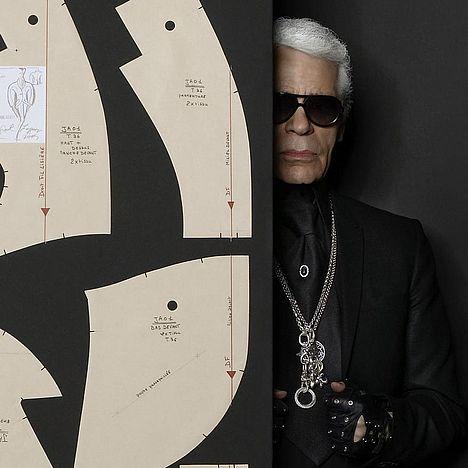
Karl Lagerfeld
Karl Lagerfeld was born in 1938 as the son of a Hamburg merchant and died in 2019 in Neuilly-sur-Seine. With his unique creations, the fashion designer, photographer and costume designer was one of the leading figures of the international fashion scene and one of the trendiest designers in the world. His eccentric clothing had a special impact on the public; his white pigtail and dark sunglasses became trademarks.
He began his career in the mid-1950s in Paris, where he worked for Pierre Balmain, Jean Patou and Chloé, among others. From 1965, he was under contract with Fendi in Rome, and from 1974, with interruptions, he also designed women’s and men’s fashion under his own name. From 1978 to 1982 he worked as a freelance designer for various houses. From 1980 to 1984 he was a guest professor in the fashion class at the University of Applied Arts Vienna.
Creative director at the French fashion house Chanel from 1983, he was credited with the revival and subsequent rise of Chanel to a billion-dollar corporation without changing Coco Chanel’s signature. From 1990, his promotion helped Claudia Schiffer, later the world’s most expensive photo model, to achieve an international breakthrough as a house model at Chanel. From 1988 to 1996, he worked with the fashion house Steilmann, and from 1996, Lagerfeld’s collections for the German mail-order company Quelle made his designs affordable for a broad following. In 2004, an exclusive and affordable autumn collection for men and women followed for the Swedish fashion label H & M. In 2010, the jewellery manufacturer Swarovski presented Karl Lagerfeld-designed bangles, necklaces and brooches, followed in 2017 by the design of the tiara for the debutantes of the Vienna Opera Ball.
In addition to fashion, Karl Lagerfeld also devoted himself to photography from the 1980s onwards and designed costumes for film, opera and ballet. In 2007, 350 of Lagerfeld’s photographs and multimedia installations were exhibited at the Berlin gallery C/O Berlin. Entitled One Man Show, they all featured US model Brad Kroenig, whom the designer had discovered and promoted.
Among his theatre works are the costumes for Luca Ronconi’s production of Berlioz’s Trojans at La Scala di Milano, his designs for Uwe Scholz’s Jeunehomme for Les Ballets de Monte-Carlo, for George Balanchine’s Brahms-Schoenberg Quartet and Ravel’s Boléro in Ohad Naharin’s choreography for the Ballet de l’Opéra de Paris, as well as the costumes for Jürgen Flimm’s production of Hofmannsthal’s Der Schwierige in a Salzburg Festival production that was also seen at Vienna’s Burgtheater.
Lagerfeld has received numerous awards for his fashion creations as well as his photographic work, including the Bambi in 1985 and 2005, the Lucky Strike Designer Award in 1993, the World Fashion Award in 2003 and the Elle Fashion Star Award in 2008 for his lifetime achievement. With the appointment as Commandeur de L’Ordre national de la Légion d’honneur, Karl Lagerfeld received the highest award of the French state in 2010, in 2015 he was honoured with the Outstanding Achievement Award of the British Fashion Council, in 2017 with the Médaille Grand Vermeil of the city of Paris.